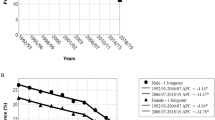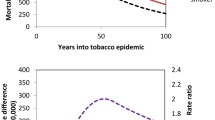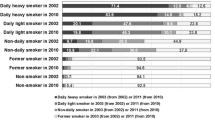Summary
Frequency and determinants of smoking cessation were analysed using data from two Italian National Health Surveys, conducted in 1983 and 1986–87 on samples of 89753 and 77155 individuals respectively, randomly selected within strata of region of residence, size of the municipality and of the household, in order to be representative of the general Italian population. Overall stopping ratios or “quit ratios” (i.e., ratios between ex- and eversmokers) were 20.5% for males and 9.0% for females in the 1983 survey, and rose to 23.2 and 11.9% respectively in 1986–87. With reference to age, stopping rates were slightly higher for females than for males below age 35, but considerably higher for males in each subsequent age group, particularly in middle age. Ratios were apparently higher for the most recent survey for both sexes and each subsequent age group. After standardisation for age, “quit ratios” in both sexes were directly related with education. Cessation of smoking was more common in northern (and richer) areas of the country, and positively associated with the prevalence of smoking-related chronic diseases. The major, and most discouraging, finding from these analyses is the absolute low rate of stopping in Italy as compared to northern America or northern Europe, although some positive tendency towards increasing cessation was evident between the early and the late 1980s. These tendencies, together with some recent drops in smoking prevalence in younger women, first observed after decades of increase, indicate a change at least in attitudes towards reporting smoking, and hence social acceptance of the habit. Still, women, as well as less educated individuals of both sexes, particularly from the less developed areas of the country, remain major targets for focusing attention and intervention for smoking cessation programmes.
Résumé
La fréquence et les déterminants pour l'interruption de fumer ont été analysés en utilisant les données de deux études de l'Office de Statistique National Italien, menées en 1983 et en 1986–87 avec des échantillons de 89753 et 77155 individus respectivement, sélectionnés au hasard, dans des strates d'habitation, par région, indépendamment de la grandeur des communes et des ménages, afin qu'ils soient représentatifs de la population italienne en général. Les proportions globales d'interruption (c'est-à-dire les rapports entre les ex-fumeurs et les fumeurs de longue date) étaient de 20.5% pour les hommes et de 9.0% pour les femmes dans l'étude de 1983 et ont augmenté jusqu' à 23.2 et 11.9% respectivement en 1986–87. En ce qui concerne l'âge des personnes, les taux d'interruption étaient légèrement supérieurs chez les femmes comparés avec ceux des hommes en-dessous de 35 ans, mais considérablement plus élevés pour les hommes dans chaque groupe d'âge supérieur, spécialement dans la cinquantaine. Les proportions pour les deux sexes étaient apparemment plus élevées dans la toute dernière étude et pour chaque groupe d'âge. Après standardisation selon l'âge, les proportions d'interruption étaient directement liées au niveau d'éducation dans les deux sexes. L'interruption de fumer était plus répandue dans les régions du nord (plus riches) du pays et indéniablement associée à la prédominance de maladies chroniques dues à la fumée de tabac. Le résultat principal, et le plus décourageant, émanant de cette analyse est le fait que le taux d'interruption est indiscutablement bas en Italie, si l'on fait la comparaison avec l'Amérique du Nord ou le Nord de l'Europe, bien qu'une tendance positive envers une interruption croissante ait été évidente au début et vers la fin des années 1980. Ces tendances indiquent, tout comme une baisse récente dans la tendance à fumer chez les jeunes femmes, observée pour la première fois après des décades de croissance, un changement au moins dans les attitudes vis-à-vis de l'image attribuée à la fumée de tabac et à l'acceptation sociale de l'habitude qui en résulte. Néanmoins, les femmes, et les personnes des deux sexes ayant une éducation plus modeste, spécialement en provenance des régions les moins développées du pays, restent la cible principale sur laquelle nous devons concentrer notre attention en intervenant avec des programmes pour l'interruption de fumer.
Zusammenfassung
Wie häufig mit Rauchen aufgehört wird sowie diesbezügliche mitbestimmende Determinanten wurden anhand der Daten von zwei Nationalen Health Surveys (NHS) in Italien untersucht. Die Surveys waren 1983 und 1986/87 mit Stichprobengrössen von 89 753, resp. 77155 durchgeführt worden. Die Stichproben waren zufällig ausgewählt worden nach Stratifizierung der Variabeln Region des Wohnorts, Gemeinde- und Haushaltgrösse, um ein repräsentatives Sample der italienischen Bevölkerung untersuchen zu können. Die Raten — Probanden, die aufhörten zu rauchen —(“quit ratios”, d.h. Rate zwischen Ex- und allen Rauchern) betrugen bei den Männern 20% und bei den Frauen 9,0% im NHS 1983, sowie 23,2% und 11,9% in NHS 1986–87. Unter Berücksichtigung des Alters waren die entsprechenden Raten bei den unter 35jährigen Frauen etwas höher als bei den Männern. In den folgenden Alterskategorien war die entsprechende Rate bei den Männern deutlich höher, vor allem bei der Kategorie “middle age”. Die Raten waren auch sichtbar höher bei beiden Geschlechtern und jeder Alterskategorie im letzten Survey. Nach der Altersstandardisierung gab es bei beiden Geschlechtern eine “quit ratio”, die direkt mit der Erziehung/Bildung korreliert war. Mit rauchen wurde häufiger in den nördlicheren (reicheren) Landesteilen aufgehört, wobei sich eine positive Assoziation der Prävalenz von Nikotinabusus bedingten chronischer Erkrankungen ergab. Der bedeutendste und am meisten enttäuschendste Befund der Analysen war, dass in Italien im Vergleich zu nordamerikanischen und-europäischen Ländern eine sehr niedrige Rate von Probanden gefunden wurde, die mit Rauchen aufhörte. Jedoch liessen sich auch in der italienischen Bevölkerung einige positive Tendenzen hinsichtlich dem Stop des Nikotinkonsums zwischen anfangs und Ende der 80iger Jahre finden. Diese Tendenzen sowie die Tatsache, dass seit kürzerem die Raucherprävalenz bei jüngeren Frauen abnimmt — nachdem während Dekaden eine Zunahme zu verzeichnen war — zeigen wenigstens eine Verhaltensänderung bezüglich der Angabe zu Rauchen, und somit auch möglicherweise eine Änderung der sozialen Akzeptanz des Rauchens. Trotzdem bleiben Frauen, und Frauen sowie Männer aus unteren sozialen Schichten, besonders aus weniger entwickelten Landesgebieten, die Hauptzielgruppen bezüglich Aufklärungs- und Interventionsprogrammen zur Raucherinnenentwöhnung.
Similar content being viewed by others
References
U.S. Department of Health and Human Services: The Surgeon General's 1990 Report on The Health Benefits of Smoking Cessation, Washington, DC, US, G.P.P., 1990.
Garfinkel L, Stellman SD. Cigarette smoking among physicians, dentists, and nurses. CA, 1986;36: 2–8.
Doll R, Peto R. Mortality in relation to smoking: 20 years' observations on male British doctors. BMJ, 1976;2: 1525–1536.
Fiore MC, Novotny TE, Pierce JP, Hatziandreu EJ, Patel KM, Davis RM. Trends in cigarette smoking in the United States. The changing influence of gender and race. JAMA 1989;261: 49–55.
ISTAT (Instituto Centrale di Statistica): Indagine statistica sulle condizioni di salute della popolazione e sul ricorso ai servizi sanitari, Novembre 1983. Note e Relazioni 1986, n. 1.
ISTAT (Instituto Centrale di Statistica): Indagine sulle condizioni di salute della popolazione e sul ricorso ai servizi sanitari. Novembre 1986–Aprile 1987. Primi risultati. Notiziario ISTAT 1987; 8: no. 17.
Negri E, Pagano R, La Vecchia C. Determinants of stopping cigarette smoking in Italy. Rev Epidemiol Santè Publique, 1989;37: 337–344.
Negri E, Ferraroni M, Pagano R, La Vecchia C. Determinants of stopping smoking in the 1986–87 Italian National Health Survey. Am J Public Health 1989;79: 1307–1308.
Ferraroni M, La Vecchia C, Pagano R, Negri E, Decarli A. Smoking in Italy, 1986–1987. Tumori, 198975: 521–526.
La Vecchia C, Negri E, Pagano R. Recent decline of smoking in younger Italian women. Int J Epidemiol 1990;19: 221.
Kabat GC, Wynder EL. Determinants of quitting smoking. Am J Public health 1987;77: 1301–1305.
Pagano R, Negri E, Decarli A, La Vecchia C. Smoking and weight in the 1983 Italian national Health Survey. Int J Obes 1987;11: 333–338.
La Vecchia C. Patterns of cigarette smoking and trends in lung cancer mortality in Italy. J Epidemiol Commun Health 1985;39: 157–164.
La Vecchia C, Garattini S. Attitudes to legislation on restriction of smoking. Lancet 1987;1: 1310.
Author information
Authors and Affiliations
Rights and permissions
About this article
Cite this article
La Vecchia, C., Negri, E., Pagano, R. et al. Socio-demographic determinants of stopping smoking from Italian population-based surveys. Soz Präventivmed 36, 154–158 (1991). https://doi.org/10.1007/BF01352694
Issue Date:
DOI: https://doi.org/10.1007/BF01352694




